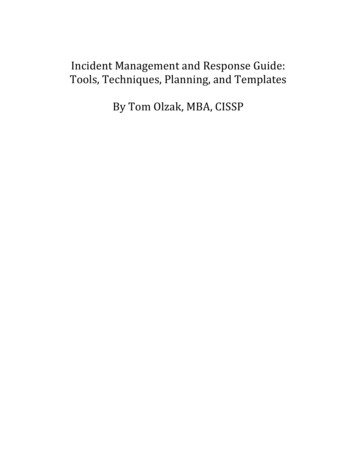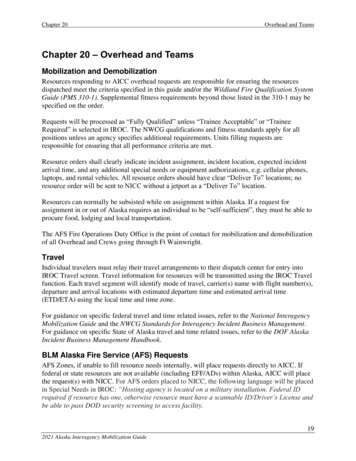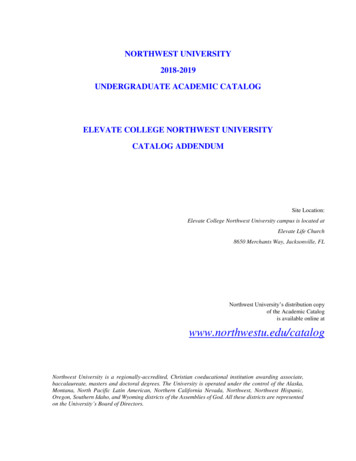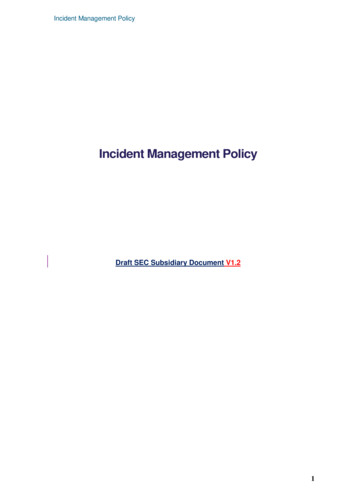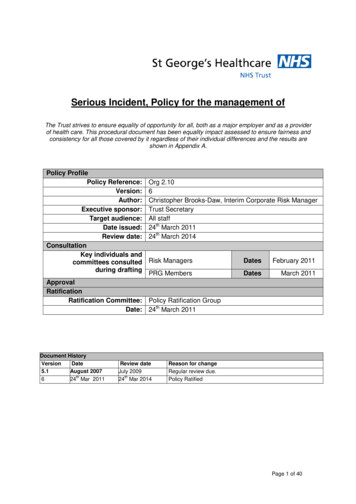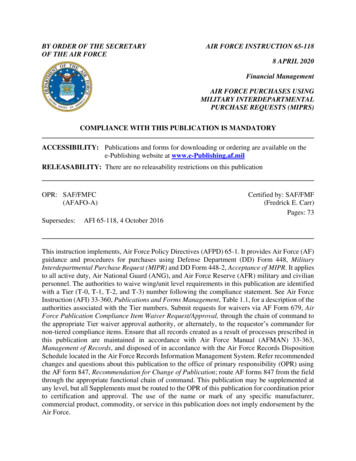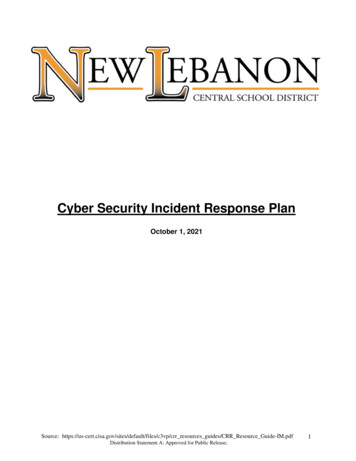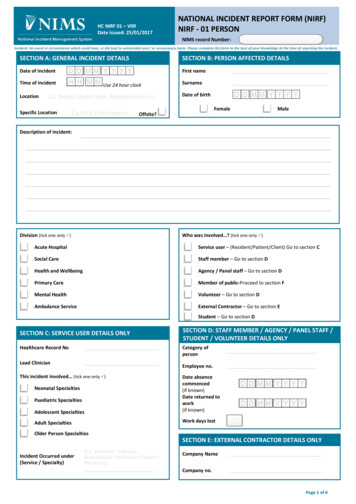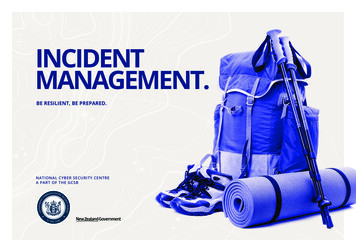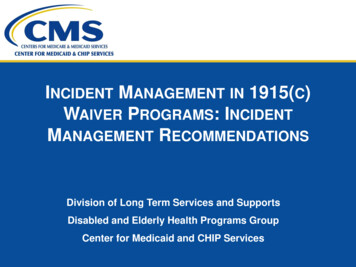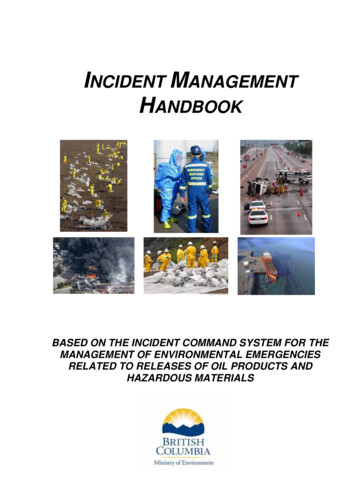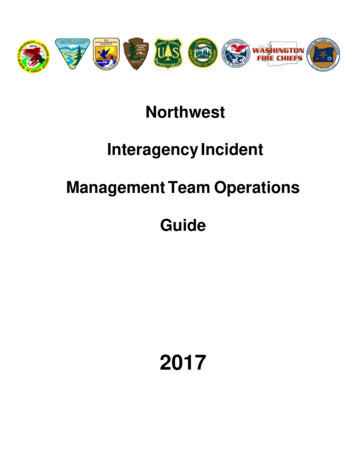
Transcription
NorthwestInteragency IncidentManagement Team OperationsGuide2017
Northwest InteragencyIncident Management Team Operations Guide2017Table of ContentsOperations Guide . 3Objectives . 4Expectations. 5What the Teams can expect from the Agency Administrator/Line Officer . 6Team Training . 7Team Selection . 8Selection Guidelines . 8Primary Team Members . 9Primary Team Member Availability and Substitution . 9Alternate Members. 9Trainee Pool Members. 9Apprentices / Non-Qualified Individuals . 10Performance or Conduct Issues . 10Team Performance Reviews . 10Team Mobilization . 10Team Rotation . 102 Page
Northwest InteragencyIncident Management Team Operations Guide2017IntroductionNorthwest Interagency Incident Management TeamsThis document guides the operation of the 10 - Northwest Interagency IncidentManagement Area Teams (IMTs), herein referred to as the Team(s). There are 8 Type IITeams and 2 Type I Teams that comprise the IMT’s in the Northwest, herein referred asNW. The Teams may include individuals from the following agencies and affiliates:o USDA Forest Serviceo USDI Bureau of Land Managemento USDI Fish and Wildlife Serviceso USDI Bureau of Indian Affairso USDI National Park Serviceo Washington Department of Natural Resourceso Washington State Fire Marshal’s Officeo Washington Fire Chiefs’ Associationo Oregon Department of Forestryo Oregon Fire Chiefs’ Associationo Oregon State Fire Marshal’s OfficeOperations GuideThe NW Incident Management Team Operations Guide, herein referred to as the Guide, isdeveloped by the Northwest Geographic Area Board, herein referred to as the Board, andreviewed by the Incident Commanders. It is intended to serve as an aid in providingassistance to teams, team members, alternate members, and trainees in preparing for andfulfilling their assignments.This Guide should be used in conjunction with Existing Team Handbooks the Wildland FireIncident Management Field Guide (PMS-210) NW Interagency Mob Guide, herein referredas NW Mob guide Interagency Standards for Fire, Fire Aviation Operations (aka “Redbook”),and the Bureau of Indian Affairs Wildland Fire and Aviation Program Management andOperations Guide (aka "Bluebook”) with the understanding that each Team may need toadapt procedures to fit the circumstances of a specific assignment. The effective andefficient management of major emergency or critical incidents requires that a Team remainflexible, have freedom to apply sound judgment, and exercise creativity in action, planningand operations to achieve desired ends.As a Guide, this document is intended to be used as one of many tools available toteams to effectively deal with circumstances and conditions of an incident.This Guide does not replace any members home agency rules or policies. With eachTeam having members from several different agencies it is not possible to addressevery situation and how that rule or policy would apply. Each team member isresponsible to notify their Team Supervisor if an order or assignment would be inconflict with an agency rule or policy, so that a workable solution can be found.3 Page
Northwest InteragencyIncident Management Team Operations Guide2017Objectives To balance the workload among the NW Area Teams, providing opportunities for allteams to be exercised on a regular basis. Build foundations for teams. The Guidelines are intended to become a frameworkfor the teams to work within and may be augmented with each team’s StandardOperating Procedures, etc. Improve successional planning across the NW geographic area, including a focuson the prioritization and management of trainees. Balance skill sets across the geographic area. Increase partnership involvement, participation and the addition of new teammembers from non-traditional sources. To create/increase broader geographic team influence through the diversification ofteams. Over time each team will gain members, knowledge and expertise acrosssub-geographic areas increasing and strengthening local knowledge andrelationships. Build and improve relationships between Agency Administrators and IMTs. Provide tools to IMTs (trainee pool, alternate list, etc.) The Teams will manage an incident in a manner that ensures the safety of allincident personnel and the general public, promotes fiscal responsibility, considersresource values and incorporate specific Agency Administrator direction. The Teams will support transitions with existing incident organization or a newincoming organization which promotes the success of meeting incident objectives.This is done in a professional manner which exhibits "command and control" to theagency and the public.4 Page
Northwest InteragencyIncident Management Team Operations Guide2017ExpectationsPersonal and Public Safety Comes FirstAll Team Members are responsible for safety on the incident, including: Personal safety Safety of others Correct and/or Report unsafe conditions or acts immediatelyBeing a Team that can minimize the incident impact on the host agency and localcommunity Cooperate with host agency Identify and involve affected stakeholders Involve the community Support the economy of the local communities Provide timely and coordinated evacuation information to public Keep the community informed on incident progressPractice and provide a safe and healthy environment by following the Firefighter Code ofConduct and Strategic Risk Assessment process to comply with: Standard Fire Orders Watch Out SituationsBe professional; respect the rights and opinions of others and practice mutual respect.Achieving Team gratification through a quality and professional performanceWhat the Agency Administrator/Geographic Board can expect from the Teams Discussion on the feasibility of accomplishing objectives and the selected Course ofAction with consideration of values at risk vs. firefighter exposure (i.e. Strategic RiskAssessment). Assistance in providing documentation of the information as stated in the Delegation ofAuthority or Task Order and in the case of federal wildland fire, a Wildland FireDecision Support System (WFDSS) and Strategic Risk Assessment (if applicable). Operations are conducted in conformance with the Delegation of Authority or TaskOrder, Agency Administrator Letter of Intent, the WFDSS and any additional writtendirection issued by the Agency Administrator/Line Officer (AA/LO) within theestablished standards and guidelines of the hosting agency. Professional conduct from individuals assigned to the incident, especially from Teammembers. Daily Meetings with the IC, if needed. Frequent information transfers from the Teamto those individuals the AA/LO has designated. A facilitated daily cooperator meeting, as needed. An understanding of the local socio-economic and political concerns of the AA/LO A complete and comprehensive financial and property accountability package. Provide adocument box that follows the national template. Documentation of the decisions made by the Team, including a final fire package.5 Page
Northwest InteragencyIncident Management Team Operations Guide2017 Efficient use of resources assigned to the incident with emphasis on safety and costcontainment. Attention to Human Resource issues, with an intolerance of discriminatory ordemeaning actions. The team will lead and facilitate an incident closeout. Attention to Safety as a primaryconcern. ADs selected for Command and General Staff positions in the absence of an agencyemployee, must be paired with an agency trainee.What the Teams can expect from the Agency Administrator/Line Officer The IC should have adequate access to the AA/LO for clarification ofobjectives and other associated items.The Team should be given a comprehensive briefing on the situation and clearobjectives, prior to assumption of command, by the AA/LO. A delegation ofauthority, WFDSS/Strategic Risk Assessment (if applicable), maps and anyspecial instructions should be available at that briefing.A representative should be available to the Team to make decisions if the AA/LO isnot readily available.Local subordinates should understand AA/LO objectives and be supportive of such.Protocols for ordering CISM and associated roles and responsibilities.The AA/LO should express, either to the team or IC, any reservations orconcerns about prior experiences so the Team has the ability to deal with themopenly.The Team should receive ongoing direct feedback on performance, orquestions about performance, from the AA/LO to the IC, or from subordinates toTeam members. Recommend following the Red Book/Blue Book standard.The Team should be allowed to function within the parameters established in theDelegation of Authority. Changes in directions should occur with changes in thedelegations or task order to insure timely implementation.The Team should clearly understand local concerns and key contacts, protocolregarding the release of information and primary contacts for emergencies. The TeamInformation Unit needs prompt admin access to Inciweb from the public affairs contactand a supply of local unit maps.AA/LO should provide the team with a local resource advisor.An expectation that a sound risk management process will be reflected in AA/LOdirection.Provide a copy of the unit’s Emergency Operations Plan.6 Page
Northwest InteragencyIncident Management Team Operations Guide2017Team TrainingEach spring, the NW Interagency Incident Management Teams will meet for a trainingsession, as budget and agency priorities allow called - Team Training. Two of the teamson a rotational basis are responsible for organizing and coordinating the training. TheTeam Training will be developed in coordination with the NW Geographic Board.The Incident Commanders will receive a Delegation of Authority from the Board providingspecific directions and objective for the following year prior to fire season. One IncidentCommander will be assigned to the Board to represent the Teams as part of their duties.The assigned IC will report on a regular basis to the Board. An Agenda will be provided atthe January Board meeting for review.Team PoliciesIC and Teams will develop policies consistent with the Northwest Interagency IncidentManagement Team Operations Guide. Individual Team Policies will be reviewed bythe IC to ensure consistency.Regulatory ComplianceTeams need to ensure that injuries and accidents are properly documented as perresponsible agencies policy r equir ements , so that follow up investigation canbe done by the appropriate jurisdiction(s).Team ConfigurationsReference the Current National Mobilization Guide Standards, Chapter 20 Overhead andTeams and the NW Mob guide.In addition, team trainees are assigned to meet position needs as prioritized by theBoard in consultation with the Incident Commander. A team may have more than sixtrainees, but numbers above six needs to be negotiated and agreed to by line officers oragency administrators.7 Page
Northwest InteragencyIncident Management Team Operations Guide2017Team SelectionThere are four categories of Team members: Primary Alternate Trainees Mentees (420/520 mentees are managed by the PNW Training Program)Selection GuidelinesThese guidelines are used to select primary members, alternates and trainees: Active agency/cooperator personnel are selected before retired (AD) or FireDepartment supplemental personnel.Candidates with potential and desire for advancement through the Type II Teamorganization to National Team positions; should be identified and given strongconsideration for advancement in the selection process.Incident Commanders, including primary, deputies, alternates and trainees, areselected by the Board. Incident Commanders will be consulted concerning theselections of Deputies, and Trainees.The Board will review and approve team members. For vacant/unfilled positions onC & G the IC will notify the Board.NW Mob guide describes team configurations and temporary replacements forPrimary C&G members. A team will be considered unavailable for assignment if it isnecessary to have more than two (2) substitutes to fill Command/General Staffpositions. Host agency, with GeoBoard concurrence, may approve exceptions.Approved alternate pool members and primary Team members from other NWteams may be used as primary C & G to fill vacancies without prior approval from theBoard. Fill-ins to the C& G from outside the GA will require approval of the Board.See NW Mob Guide for additional requirements.The Board representative for each applicant's agency is responsible for ensuring thatapplicants from their agency are fully qualified to be considered for the position forwhich they applied. Interagency skill mixes need to be evident when eachInteragency IMT roster is evaluated, this is especially important for the OperationsSection.8 Page
Northwest InteragencyIncident Management Team Operations Guide2017Primary Team MembersAre fully qualified for the position assigned and are listed on the team roster. Primary teammembers are expected to be available for dispatch whenever their team is in the “up”position in the rotation schedule.Primary Team Member Availability and SubstitutionWhen a primary team member is unavailable for dispatch with his or her team, he/sheis responsible to immediately contact his/her Section Chief or Incident Commander.When a standing team member is unavailable for dispatch with his or her team, he/she isresponsible to immediately contact his/her Section Chief or Incident Commander, and thehome dispatch office.The Section Chief or IC may select a replacement from the Alternate Pool. Alternatemembers should be provided opportunity to accept an assignment before other qualifiedpeople are contacted. The IC is responsible for notifying their host dispatch center of thechanges.Alternate MembersThe alternate members are fully qualified for the positions listed, and are available tosubstitute for, or supplement, primary team members on active rosters. A list of Alternateswill be provided prior to the start of the season. The Alternate list will be the primary sourceof replacements Pre-Mobilization.Trainee Pool MembersTwo lists of Trainees will be maintained, Priority Trainees and those identified by each Team.The Board may choose to prioritize positions/people in the Trainee Pool for assignment.The first opportunity for training assignments is given to the person assigned top priority fora given position. The Board will work with the Redmond Training Center and WashingtonDNR Olympia dispatch to manage the Priority Trainee Pool. Trainees prioritized to meetIFPM requirements are responsible for notifying the Redmond Training Center and/orOlympia Dispatch and Incident Commander of changes in their qualifications and availabilityTrainees assigned to a teams should complete their task book as soon as practical andbe recommended for certification when appropriate. Once certified, the trainee is to bemoved to the Alternate list and the next trainee for that positon should be given theopportunity to work on their taskbook. The intent is to qualify as many personnel aspossible each season by affording opportunities to more trainees.9 Page
Northwest InteragencyIncident Management Team Operations Guide2017Apprentices / Non-Qualified IndividualsThe Board encourages the use of apprentices. This type of assignment is intended tohelp sustain adequate numbers of qualified individuals over time; as such, they areintended to compliment formal trainee assignments. Apprentices differ from trainees inthat they have an interest in IMTs but lack the experience or prerequisite trainingnecessary to be issued a Position Task Book for a specific ICS position.The objective of an apprentice assignment is accelerated career development of theindividual and eventual qualification for assignment to IMTs. They can contribute to thetask at hand by providing some additional help to the incident, but are not to be reliedupon to meet incident objectives.Implementation of Apprentice use: Teams will report to the Board annually on the progress of assignedApprentices Will be included as one of the 50 approved IMT positions unlessotherwise negotiatedPerformance or Conduct IssuesThe Incident Commander for each team has the right to replace team members at anytime for poor performance, unavailability, or unacceptable behavior. Such decisionsshall be documented in writing and sent to the Geographic Board member representingthe employing agency of the replaced team member.Team Performance ReviewsPrior to each fire season the Board will provide each Incident Commander with a signeddocument that establishes mutual performance expectations. A representative of the Boardwill endeavor to attend each team in-brief and or close-out to hear first-hand about issuesand concerns. The Board will provide feedback to each Incident Commander at the end ofthe season about his or her performance as an Incident Commander . Performancereviews are signed by both parties and a copy is sent to the Chair of the Board.Team MobilizationReference the NW Mob Guide: Chapter 20 Overhead and TeamsTeam RotationReference the NW Mob Guide: Chapter 20 Overhead and Teams10 P a g e
This Guide should be used in conjunction with Existing Team Handbooks the Wildland Fire Incident Management Field Guide (PMS-210) NW Interagency Mob Guide, herein referred as NW Mob guide Interagency Standards for Fire, Fire Aviation Operations (aka "Redbook"), and the Bureau of Indian Affairs Wildland Fire and Aviation Program Management and
